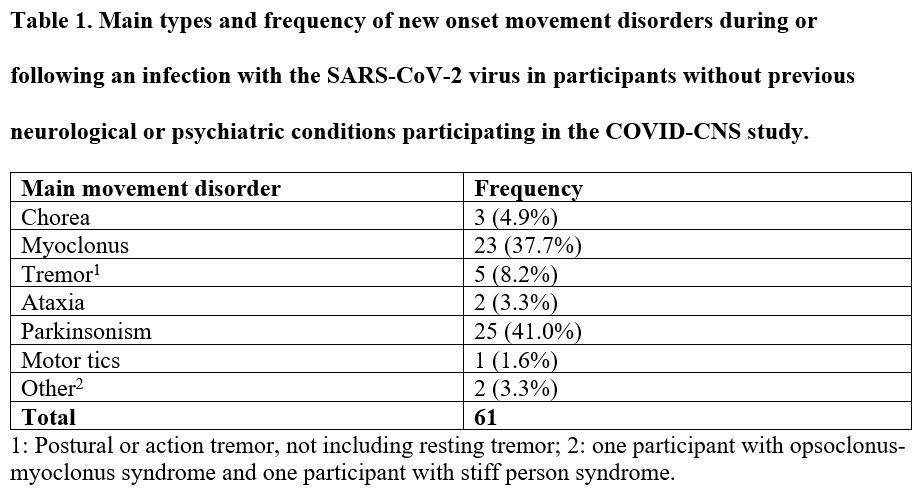Category: Parkinsonism, Others
Objective: To determine the prevalence and phenotype of movement disorders following SARS-CoV-2 infection in hospitalised individuals.
Background: Although movement disorders, including parkinsonism, following SARS-CoV-2 (COVID-19) infection have been described, the literature is largely limited to case reports and case series.
Method: Cross-sectional analysis of 805 participants in the prospective COVID-CNS study in the United Kingdom. We identified participants who developed any type of movement disorder following a confirmed infection and hospitalisation with SARS-CoV-19 between March 2020 and October 2022. We compared baseline characteristics, e.g. severity of SARS-CoV-2 infection, duration of hospitalisation, and ethnicity between those who developed a movement disorder and: 1) participants who developed neurological complications (excluding movement disorders) after SARS-CoV-2 infection, and 2) participants who did not develop neurological complications following SARS-CoV-2 infection. In addition, we assessed possible volumetry and intensity changes using T1 and T2 FLAIR analysis in a sub-set of this group compared to matched participants from group 2.
Results: Of the 805 participants in the COVID-CNS study, 405 (50.3%) developed neurological complications of whom 61 participants (15.1%) had a new onset movement disorder during or following SARS-CoV-2 infection. The most common movement disorders were parkinsonism (41.0%) and myoclonus (37.7%)[Table 1]. The main risk factor for movement disorders seemed to be self-reported Black ethnicity (24.6% vs 8.7% in other neurological cases; p=0.004), as well as overall duration of admission compared to COVID-19 positive controls. Of the 61 participants with new onset movement disorder, 21 participants (34.4%) had corresponding imaging. No differences in the grey and white matter volumes or hyperintensities in the basal ganglia, brainstem or cerebellum were noted between participants with movement disorders and COVID-19 positive controls.
Conclusion: Movement disorders occurred in an estimated 15% of hospitalised patients with neurological complications of COVID-19, most commonly in the form of parkinsonism and myoclonus. Participants from Black ethnic minority background seemed to be at greater risk for development of movement disorders. Further research into the reasons for the development of movement disorders and neurological complications following SARS-CoV-2 and the role of ethnicity is warranted.
Table 1
To cite this abstract in AMA style:
D. van Wamelen, B. Facer, S. Rota, M. Bonello, K. Chaudhuri, G. Breen, B. Michael. New onset movement disorders following COVID-19 infection [abstract]. Mov Disord. 2024; 39 (suppl 1). https://www.mdsabstracts.org/abstract/new-onset-movement-disorders-following-covid-19-infection/. Accessed January 5, 2026.« Back to 2024 International Congress
MDS Abstracts - https://www.mdsabstracts.org/abstract/new-onset-movement-disorders-following-covid-19-infection/

